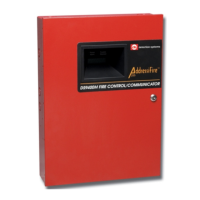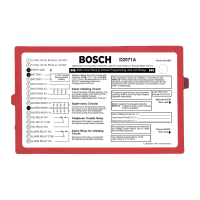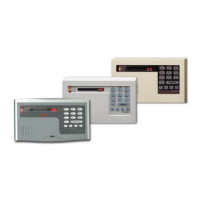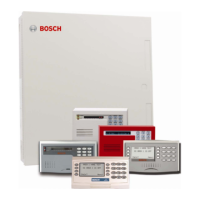DS7200V2-UK Installer’s Guide
Aux
Pwr
+
Note 1
: Jumper PO1 must be in place for connection
to NAC or other powered alarm device.
Installer
Keypad
Lock
Installer
Switch
Green
Yellow
Red
Black
ABCD
P
S
Keypads, Expanders
Printer modules &
Communication modules
(up to 19 total devices)
P
S
P
S
P
S
Data
Data
Auxilliary Powered Devices 11.5 to 12.4 VDC.
With 7.0 Ah battery,180 mA for 24 hrs for Fire and
Combined Fire/Burglary. 1.2 A for other.
Include keypads in calculations.
POWER SUPPLY REQUIREMENTS
The Power Supply provides a maximum of 1.2 A for battery charging and all accessory devices.
Requirements for battery standby time may reduce allowable output.
CAUTION
: See Installer’s Guide P/N: 4998152533 for power requirements relating to terminals
[Alrm+] and [+Aux Pwr] (+12 VDC).
Outputs PO3 & PO4 can sink up
to 500 mA 12 VDC.
See DS7240V2-UK Installer’s Guide
P/N: 4998152533 for System Wiring Diagram
Supervised with 2k2
Ω
EOL Resistors
(P/N:47819).
Typical Initiating Devices
are Door Contacts NO/NC,
Floor Mats, Motion
Sensors, Glass Break
Detectors, etc.
R1
T1
R
T
Incoming
Phone
Line
Premises
Phone
PO1 Terminals can be configured as an alarm power output.
PO1 Jumper must be closed.
Orange
Yellow
Green/
Yellow
Blue
Brown
Rated Voltage: 230 V
Rated Frequency: 50 Hz
Rated Input Current: 250 mA max.
For PERMANENTLY CONNECTED
EQUIPMENT, a readily accessible
disconnect device shall be incorporated
into the building installation wiring.
CAUTION
RISK OF EXPLOSION IF
BATTERY IS REPLACED BY AN
INCORRECT TYPE.
DISPOSE OF USED BATTERIES
ACCORDING TO THE
INSTRUCTIONS
Maximum charging
current is 1.5 A.
Replace Battery every 3 to 5 yrs.
with a lead acid battery such as
P/N:440054
(12 V, 7 Amp-Hr, 6 cells)
Battery Capacity
:
Min 5.0 Ah Max 18.0 Ah
Recommended Battery
Manufacturers
:
POWER SONIC:
PS-1270,
PS-12180
YUASA:
NP7-12,
NPG18-12
Green/Yellow
For continued protection against risk
of fire, replace only with same type and
rating of fuse.
Fuse Rating: 0.5 A, 250 V Slow Blow
Tamper Zones
Output PO2 can be used with
Alarm+ as a supervised siren driver.
Connect an approved 4 or 8
Ω
siren.
Alternatively, PO2 can sink up to 500 mA 12 VDC.
Wall and Lid
Tamper
Switches
NEG TRIG
+12 V
STRB NEG
Bell
Tamp 0 V
0 V
Supervised Zones
Open 10.4 to 14.0 VDC
Fault 8.3 to 9.4 VDC
Normal 6.4 to 7.4 VDC
Short 0.0 to 5.7 VDC
All Resistors
2k2
Ω
(P/N:47819)
BATT+
BATT-
ALRM
+
PO1
L-1
SMK
+
L-2COM L-4COML-3 L-6COML-5 L-8COML-7
T
T1
R1
AUXILIARY
PO1 SELECT
A B
R
L N
Figure 1: Control Panel Wiring Connections
See Table 1 for terminal descriptions.






